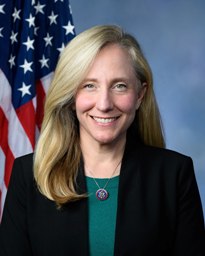Can Abigail Spanberger Win Virginia’s Governorship in a Runaway?
Democrats have not enjoyed a blow-out victory for the office since 1961
 Democrats have not held a majority of U.S. governorships since the Election of 2010, but hope to claw back one more seat this November in the Commonwealth of Virginia.
Democrats have not held a majority of U.S. governorships since the Election of 2010, but hope to claw back one more seat this November in the Commonwealth of Virginia.
A victory by former Democratic U.S. Representative Abigail Spanberger against sitting Lieutenant Governor Winsome Earle-Sears would give the Democrats 24 seats nationwide, presuming they also hold the open seat race in New Jersey this cycle.
The Spanberger vs. Earle-Sears matchup marks the first all-woman major party nominee gubernatorial ballot in Virginia history with only one other woman ever receiving a Democratic or Republican nomination for the office. [In 1993, two-term Democratic Attorney General Mary Sue Terry lost by 17.4 points to U.S. Representative George Allen with 40.9 percent of the vote].
Although Democrats have generally enjoyed a boon in Virginia over the last two decades to give the once red-leaning state a blue hue, most victories have not come easily.
Since the passage of the Civil Rights Act in 1964, Democrats have won eight of 15 gubernatorial contests, but no nominee for the office has received 56 percent or more of the vote.
The high water mark over the last 60+ years is the 55.2 percent won by sitting Attorney General Gerald Baliles in 1985.
In fact, although Democrats have won 26 of the 46 elections to the state’s three constitutional offices since 1965, its nominees have reached 56 percent or more just three times – all in races for Attorney General: incumbent Andrew Miller in 1973 (70.6 percent) and the aforementioned Mary Sue Terry as a sitting state Delegate in 1985 (61.4 percent) and as an incumbent in 1989 (63.2 percent).
Meanwhile, voters have given Republican nominees 56 percent or more of the vote in seven of the 19 elections they have won for the offices of governor, lieutenant governor, and attorney general during this span:
- 1993 (Governor): U.S. Representative George Allen, 58.3 percent
- 1993 (Attorney General): Henrico County Attorney Jim Gilmore, 56.1 percent
- 1997 (Attorney General): State Senator Mark Earley, 57.5 percent
- 2001 (Attorney General): Attorney Jerry Kilgore, 60.0 percent
- 2009 (Governor): State Delegate Bob McDonnell, 58.6 percent
- 2009 (Lieutenant Governor): Incumbent Bill Bolling, 56.5 percent
- 2009 (Attorney General): State Senator Ken Cuccinelli, 57.5 percent
Polling shows Spanberger with the edge in a state in which voters have cast their ballots against the party of the sitting president in 11 of the last 12 cycles since 1977 (with former DNC Chair Terry McAuliffe’s 2.5-point win against AG Cuccinelli the lone exception in 2013).
The status of President Donald Trump’s approval rating on Election Day could indeed play a role in whether the Spanberger vs. Earle-Sears contest is competitive or whether the former cruises to a rare double-digit victory.
In addition to this year’s major party nominees and Mary Sue Terry, the only other women to appear on a Virginia gubernatorial general election ballot are:
- 1921: Keller Independent Socialist Daphne (Mrs. George) Custis (0.1 percent)
- 1941: Richmond stenographer and Communist Alice Burke (0.1 percent)
- 1993: Lovettsville independent and The New Federalist editor Nancy Spannaus (0.8 percent)
- 1997: Dillons Fork freelance business manager and accountant and Reform Party nominee Sue Harris DeBauche (1.5 percent)
- 2021: Richmond activist and educator and Libertarian Princess Blanding (0.7 percent)
U.S. Air Force veteran Donna Charles has also filed for the office this cycle as an independent candidate.
Follow Smart Politics on X.

– Is “56 percent” the new 55%?
– There is a very good chance that the D lieutenant governor candidate will garner a higher share of the vote than the D governor candidate, due to both the national currents and the personal weaknesses of the nominee.
– I do hope this report is around for a while – at least quite a bit longer than the *Cornyn v Paxton* report.
RE: Cornyn v. Paxton: Our publishers at the U of MN switched servers a few days ago and the snapshot they used to migrate the site unfortunately did not include the most recent content. I’ll repost that TX report this afternoon.
RE: LG vis-a-vis Gov – in fact, the Democratic LG nominee has received a larger percentage of the vote than the Democratic GOV nominee in 11 of the last 15 cycles since 1965 (including 1973, in which there was no stand-along nominee for Governor).
“…since *1961*” Even 1985 – when the nominee reached the far more common 55% threshold – is a rather long time ago.
Barring a miraculous turn in favor of the state Republicans, the most fiercely contested single election may well be that for attorney general, perhaps the only winnable state-level contest winnable for them this cycle (unlike in the 2001 cycle, when the majority of the House of Delegates seats was won by the Republicans).
Despite all her flaws and the headwinds facing her party R nominee Earle-Sears managed to garner a higher share of the 2-party vote (and smaller margin of defeat) than the D gubernatorial nominees in 2009 (18% loss) and 1993 (17% loss).
Still, the comparatively modest 15% victory margin for the D gubernatorial nominee was evidently enough to pull the embattled ticket mate for attorney general over the top.